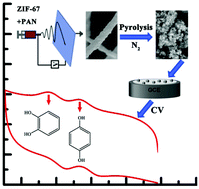MOF/PAN nanofiber-derived N-doped porous carbon materials with excellent electrochemical activity for the simultaneous determination of catechol and hydroquinone†
Abstract
In this work, ZIF-67 decorated with polyacrylonitrile (PAN) was electrospun to obtain composite ZIF-67/PAN nanofibers, which were used to construct C-ZIF-67/PAN-800 via one-step pyrolysis at 800 °C under a N2 atmosphere. Then, a strategy for constructing a sensor for the simultaneous determination of hydroquinone (HQ) and catechol (CC) was proposed using a C-ZIF-67/PAN-800-modified glass carbon electrode (GCE). Additionally, C-ZIF-67-800 was fabricated as a reference through the pyrolysis of ZIF-67 in the absence of PAN at 800 °C. C-ZIF-67/PAN-800/GCE showed much better electrochemical activity for the simultaneous determination of HQ and CC than C-ZIF-67-800/GCE. Under optimal conditions, C-ZIF-67/PAN-800/GCE exhibited a wide detection range of 1–120 μM and 1–200 μM for HQ and CC, respectively, and both detection limits were 1.0 μM. Our work proves that the electrochemical properties of MOF-derived porous carbon materials can be tuned by electrospinning.



 Please wait while we load your content...
Please wait while we load your content...